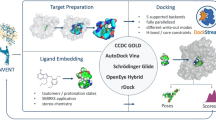Abstract
For computational de novo design, a general retrospective validation work is a very challenging task. Here we propose a comprehensive workflow to de novo design driven by the needs of computational and medicinal chemists and, at the same time, we propose a general validation scheme for this technique. The study was conducted combining a suite of already published programs developed within the framework of the NovoBench project, which involved three different pharmaceutical companies and four groups of developers. Based on 188 PDB protein–ligand complexes with diverse functions, the study involved the ligand reconstruction by means of a fragment-based de-novo design approach. The structure-based de novo search engine FlexNovo showed in five out of eight total cases the ability to reconstruct native ligands and to rank them in four cases out of five within the first five candidates. The generated structures were ranked according to their synthetic accessibilities evaluated by the program SYLVIA. This investigation showed that the final candidate molecules have about the same synthetic complexity as the respective reference ligands. Furthermore, the plausibility of being true actives was assessed through literature searches.






Similar content being viewed by others
Notes
PDB entries used in the study: 1a52 1ckp 1di8 1dm2 1e1v 1e1x 1e9h 1ere 1err 1fkn 1fvt 1fvv 1g50 1g5s 1gih 1gii 1gij 1gwq 1gwr 1gz8 1h00 1h01 1h06 1h07 1h08 1h0u 1h0v 1h0w 1h1p 1h1q 1h1r 1h1s 1jsv 1jvp 1ke5 1ke6 1ke7 1ke8 1ke9 1l2i 1ogu 1oi9 1oiq 1oir 1oit 1oiu 1oiy 1p2a 1p5e 1p8d 1pcg 1pf8 1pkd 1pq6 1pq9 1pqc 1pxi 1pxj 1pxk 1pxl 1pxm 1pxn 1pxp 1pye 1qkt 1qku 1r5k 1r78 1rkp 1ro6 1sj0 1tqf 1udt 1uom 1urw 1v1k 1vyw 1vyz 1w0x 1w51 1w8c 1wcc 1x7e 1x7r 1xlx 1xlz 1xm4 1xm6 1xmu 1xos 1xoz 1xp0 1xp1 1xp6 1xp9 1xpc 1xqc 1y2h 1y2j 1y8y 1y91 1yim 1yin 1ykr 1ym2 1ym4 1zky 1zlt 1zys 2a0c 2a4l 2ayp 2ayr 2b1v 2b1z 2b23 2b52 2b53 2b54 2b55 2b8l 2b8v 2bhe 2bhh 2bj4 2bkz 2bpm 2br1 2brb 2brg 2brh 2brm 2brn 2bro 2btr 2bts 2c3j 2c3k 2c3l 2c4g 2c5n 2c5o 2c5p 2c5t 2c5v 2c5x 2c5y 2c68 2c69 2c6i 2c6k 2c6l 2c6m 2c6o 2c6t 2cgu 2cgv 2cgw 2cgx 2chm 2clx 2duv 2erd 2ert 2esm 2etk 2eto 2etr 2exm 2f3e 2f3f 2fai 2fdp 2fvd 2g44 2g94 2g9x 2h44 2i0j 2i40 2irz 2is0 2iw6 2iw8 2iw9 2jf9 2jfa 3erd 3ert.
References
Degen J, Rarey M (2006) Chem Med Chem 1:854
Hartshorn MJ, Verdonk ML, Chessari G, Brewerton SC, Mooij WTM, Mortenson PN, Murray CW (2007) J Med Chem 50:726
Chen Y, Shoichet BK (2009) Nat Chem Biol. doi:10.1038/nchembio.155 Published Online 22-03-09
Teotico DG, Babaoglu K, Rocklin GJ, Ferreira RS, Giannetti AM, Shoichet BK (2009) Proc Natl Acad Sci 106:7455–7460
Moon JB, Howe WJ (1990) Tetrahedron Comput Methodol 3:697
Wang JW, Watson IA, Bell MA, Webster YW, Higgs RE, Vieth M (2007) 233rd ACS National Meeting, Chicago, USA, COMP-035
Rarey M, Stahl M (2001) J Comput Aided Mol Des 15:497
Pärn J, Degen J, Rarey M (2007) J Comput Aided Mol Des 21:327
Boda K, Seidel T, Gasteiger J (2006) J Comput Aided Mol Des 21:311
The software package SYLVIA is available from Molecular Networks GmbH, Erlangen, Germany (http://www.molecular-networks.com)
Symyx technologies Inc., http://www.symyx.com/products/databases/bioactivity/mddr/index.jsp. Accessed May 2009
Sadowski J, Gasteiger J, Klebe G (1994) J Chem Inf Comput Sci 34:1000
The 3D structure generator CORINA is available from Molecular Networks GmbH, Erlangen, Germany (http://www.molecular-networks.com)
Maass P, Schulz-Gasch T, Stahl T, Rarey M (2007) J Chem Inf Model 47:390
Degen J, Wegscheid-Gerlach C, Zaliani A, Rarey M (2008) Chem Med Chem 3:1503
Lipinski CA, Lombardo F, Dominy BW, Feeney PJ (2001) Adv Drug Deliv Rev 46:3
Hindle SA, Rarey M, Buning C, Lengauer T (2002) J Comput Aided Mol Des 16:129
Molecular Networks GmbH, http://www.molecular-networks.com/software/sylvia/index.html. Accessed May 2009
Hillisch A, Peters O, Kosemund D, Muller G, Walter A, Schneider B, Reddersen G, Elger W, Fritzemeier K-H (2004) Mol Endocrinol 18:1599
Doweyko AM (2007) Drug Dev Res 68:95
Veber DF, Johnson SR, Cheng HY, Smith BR, Ward KW, Kopple KD (2002) J Med Chem 45:2615
Baber JC, Feher M (2004) Mini Rev Med Chem 4:681–692
Allu TK, Oprea TI (2005) J Chem Inf Model 45:1237–1243
Acknowledgments
The authors thank the editor and the reviewers for their substantial help as well as all partners in the NovoBench Project for fruitful discussions and feedback. They also are grateful to Viola Hingst for carefully reviewing the paper and, finally, they acknowledge the German Ministry of Education and Research for funding (Grant 313324A).
Author information
Authors and Affiliations
Corresponding author
Electronic supplementary material
Below is the link to the electronic supplementary material.
Rights and permissions
About this article
Cite this article
Zaliani, A., Boda, K., Seidel, T. et al. Second-generation de novo design: a view from a medicinal chemist perspective. J Comput Aided Mol Des 23, 593–602 (2009). https://doi.org/10.1007/s10822-009-9291-2
Received:
Accepted:
Published:
Issue Date:
DOI: https://doi.org/10.1007/s10822-009-9291-2




